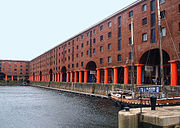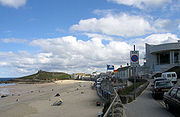
Tate
Background Information
SOS Children volunteers helped choose articles and made other curriculum material SOS Children has looked after children in Africa for forty years. Can you help their work in Africa?
The Tate is an institution that houses the United Kingdom's national collection of British Art, and International Modern and Contemporary Art. It is a network of four art museums: Tate Britain, London (previously known as the Tate Gallery, founded 1897), Tate Liverpool (founded 1988), Tate St Ives, Cornwall (founded 1993) and Tate Modern, London (founded 2000), with a complementary website, Tate Online (created 1998). It is an executive non-departmental public body of the Department for Culture, Media and Sport.
Tate is used as the operating name for the corporate body which was established by the Museums and Galleries Act 1992 as The Board of Trustees of the Tate Gallery.
The gallery was founded in 1897, as the National Gallery of British Art. When its role was changed to include the national collection of Modern Art as well as the national collection of British art, it was renamed the Tate Gallery after Henry Tate, who had laid the foundations for the collection. The Tate Gallery was housed in the current building occupied by Tate Britain which is situated in Millbank, London. In 2000, the Tate Gallery transformed itself into the current-day Tate, which consists of a federation of four museums: Tate Britain which displays the collection of British art from 1500 to the present day; Tate Modern which is also in London, houses the Tate's collection of British and International Modern and Contemporary Art from 1900 to the present day. Tate Liverpool, in Liverpool has the same purpose as Tate Modern but on a smaller scale, and Tate St Ives displays Modern and Contemporary Art by artists who have connections with the area. All four museums share the Tate Collection. One of the Tate's most publicised art events is the awarding of the annual Turner Prize, which takes place at Tate Britain.
History and development
The original Tate art gallery was called the National Gallery of British Art, situated on Millbank, Pimlico, London at the site of the former Millbank Prison. The idea of a National Gallery of British Art was first proposed in the 1820s by Sir John Leicester, Baron de Tabley. It took a step nearer when Robert Vernon gave his collection to the National Gallery in 1847. A decade later John Sheepshanks gave his collection to the South Kensington Museum (later the Victoria & Albert Museum), known for years as the National Gallery of Art (the same title as the Tate Gallery had). Forty years later Sir Henry Tate who was a sugar magnate and a major collector of Victorian art, offered to fund the building of the gallery to house British Art on the condition that the State pay for the site and revenue costs. Henry Tate also gifted the gallery his own collection. It was initially a collection solely of modern British art, concentrating on the works of modern—that is Victorian era—painters. It was controlled by the National Gallery until 1954.
In 1915, Hugh Lane bequeathed his collection of European Modern Art to Dublin, but controversially this went to the Tate, which expanded its collection to include foreign art and continued to acquire contemporary art. In 1926, and 1937, the art dealer and patron Joseph Duveen paid for two major expansions of the gallery building. His father had earlier paid for an extension to house the major part of the Turner Bequest, which in 1987 was transferred to a wing paid for by Sir Charles Clore. Henry Courtauld also endowed Tate with a purchase fund. By the mid 20th century, it was fulfilling a dual function of showing the history of British art as well as international Modern art. In 1954, the Tate Gallery was finally separated from the National Gallery.
During the 1950s and 1960s, the visual arts department of the Arts Council of Great Britain funded and organised temporary exhibitions at the Tate Gallery including, in 1966, a retrospective of Marcel Duchamp. Later, the Tate began organising its own temporary exhibition programme. In 1979 with funding from a Japanese bank a large modern extension was opened that would also house larger income generating exhibitions. In 1987, the Clore Wing opened to house the major part of the Turner bequest and also provided a 200 seat auditorium. (The "Centenary Development," in 2001, provided improved access and public amenities)
In 1988, an outpost in the North West England opened as Tate Liverpool. This shows various works of modern art from the Tate collection as well as mounting its own temporary exhibitions. In 2007, Tate Liverpool hosted the Turner Prize, the first time this has been held outside London. This is an overture to Liverpool's being the European Capital of Culture 2008.
In 1993, another offshoot opened, Tate St Ives. It exhibits work by modern British artists, particularly those of the St Ives School. Additionally the Tate also manages the Barbara Hepworth Museum and Sculpture Garden, which opened in 1980.
Neither of these two new Tates had a significant effect on the functioning of the original London Tate Gallery, whose size was increasingly proving a constraint as the collection grew. It was a logical step to separate the "British" and "Modern" aspects of the collection, and they are now housed in separate buildings in London. The original gallery is now called Tate Britain and is the national gallery for British art from 1500 to the present day, as well as some modern British art. Tate Modern, in Bankside Power Station on the south side of the Thames, opened in 2000 and now exhibits the national collection of modern art from 1900 to the present day, including some modern British art. In its first year, the Tate Modern was the most popular museum in the world, with 5,250,000 visitors.
Sir Nicholas Serota has been the director of the Tate since 1988.
Tate Online
Tate Online is the Tate's web site. Since its launch in 1998, the site has provided information on all four physical Tate galleries (Tate Britain, Tate St Ives, Tate Liverpool and Tate Modern) under the same domain. Tate Online helps visitors prepare and extend visits to the physical sites but also acts as a destination in its own right. Other resources include illustrated information on all works in Tate's Collection of British and Modern international art, structured and informal e-learning opportunities for all visitors, over 600 hours of archived webcast events, all articles from the magazine Tate Etc., and a series of bespoke net art commissions. BT was the primary sponsor of Tate Online from 2001 to 2009.
In addition to providing information about the galleries and organisation, Tate Online has been used as a platform for Internet art exhibits, termed Net Art, which are organised as part of Tate's Intermedia Art initiative covering new media art. So far, 13 net art exhibitions have been shown since the initiative started in 2000 including Tate in Space (2002) which was nominated in the Interactive Art category for the 2003 BAFTA Interactive awards.
Administration
The Tate receives annual funding from the Department for Culture, Media & Sport. It is administered by a board of trustees, who are responsible for the running of the gallery and appoint the Director (for a period of seven years). Under the Charities Act 1993, the Tate is an exempt charity accountable directly to Government rather than the Charity Commission for financial returns etc. However, the Trustees are still expected to follow the broad responsibilities of charity trustees, and may be subject to Charity Commission oversight on these elements of their activities.
Various bodies have been set up to support the Tate including Tate Members for the general public, where a yearly fee gives rights such as free entry to charging exhibitions and members rooms. There is also Tate Patrons for a higher subscription fee and the Tate Foundation. There are a number of corporate sponsors. In addition individual shows are often sponsored.
The Outset Contemporary Art Fund was established in 2003, by Tate patrons Yana Peel and Candida Gertler. In collaboration with the Frieze Art Fair, the fund buys works from the fair for the Tate's collections.
Controversies
- In the 19th century, there was dispute over the acquisitions made with the Chantrey bequest and accusations that favouritism resulted in the purchase of dull work by Royal Academicians
- In 1971, an exhibition by Robert Morris called Bodyspacemotionthings was closed after five days due to health and safety concerns
- In 1972, the Tate Gallery purchased a work by Carl Andre called Equivalent VIII. During a 1976 exhibition of the work, The Times newspaper published an article using the work to complain about institutional waste of taxpayers' money. The article made the piece infamous and it was subjected to ridicule in the media and vandalism. The work is still popularly known as "The Bricks," and has entered the British public lexicon
- Each year, the Turner Prize is held at a Tate Gallery (historically at Tate Britain) and is awarded to an artist under 50 who is either British or primarily working in Great Britain. It is the subject of great controversy and creates much media attention for contemporary British art, as well as attracting demonstrations
- In 1995, it was revealed that the Tate had accepted a gift of £20,000 from art fraudster John Drewe. The gallery had given Drewe access to its archives which he then used to forge documents authenticating fake modern paintings that he then sold
- In 1998, Sir Nicholas Serota, director of Tate, conceived 'Operation Cobalt', the secret and ultimately successful buyback of two of the Tate's paintings by JMW Turner that had been stolen from a German gallery in 1994. See Frankfurt art theft (1994)
- Charles Saatchi stated that an offer of a major gift of works was rejected by Serota. Serota responded that no such offer had been made
- In 2005, the Stuckists offered a donation of 175 paintings which had been exhibited at the Walker Art Gallery. This was rejected and the Tate was accused of "snubbing one of Britain’s foremost collections"
- In 2005, there was a scandal over the Tate's purchase of its trustee Chris Ofili's work The Upper Room for £705,000, and accusations of conflict of interest In July 2006, the Charity Commission completed an investigation into this and censured the gallery for acting outside its legal powers
- In 2006, a legal opinion was given that the Tate and National Gallery have no legal right to ownership of the Turner Bequest, as Turner's conditions for that had never been fulfilled and are still binding
- In 2006, it was revealed that the Tate was the only national-funded museum not to be accredited to the Museums, Libraries and Archives Council (MLA), as it did not wish to abide by guidelines that deaccessioned work should first be offered to other museums. The MLA threatened to bar the Tate from acquiring works under the Acceptance in Lieu (AIL) scheme, whereby works are given to the nation to settle inheritance tax. A total of 1,800 museums are accredited with the MLA




